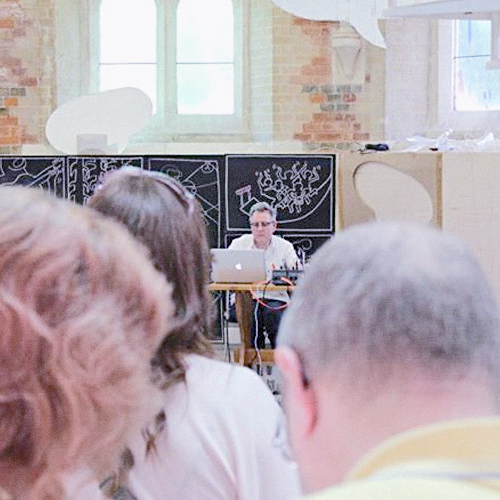Interview with Sebastiane Hegarty part II
by Jay Dea Lopez
Sebastiane Hegarty is an artist, writer and lecturer. His creative practice is interdisciplinary and time-based, including: sound, installation, photography, performance, drawing and text. His work is concerned with memory through an exploration of the relationship between time, place, and sensation. Most recently this has focused on acoustic ecology and the perceptual geographies of sound and audition.
Sebastiane has exhibited extensively in a wide range of media. Most recently his audio essay, Listening and walking was broadcast on Twenty Minutes (BBC Radio 3) and a series of soundscapes for Radio Solent, resulted in a two part documentary, extracts from which featured on BBC Radio 4′s Pick of the Week.
In this exclusive interview for the Field Reporter, Jay-Dea Lopez speaks with Hegarty about his background in film and installation, his recent projects “Chalk Studies” and the “Winnall Moors Project”, and the differences between listening to live and recorded sound.
Q (JDL). During 2013 you are working on a series of four recorded soundwalks in the Winnall Moors Reserve in Winchester, England. Each soundwalk features sounds recorded during one season. Can you describe the differences that you have heard between the seasons, and what is it about this particular reserve that has attracted your attention?
A (SH). When I first moved to Winchester to study for my MA (Sculpture), the moors were visible from my studio and I would often walk their circuit when the noise of making and thinking got too much. It has remained part of my everyday life. My work is concerned with our perception of time and place, so I was interested in the moors as an area of conservation (a place protected from change). I was also interested in its locality, an area of local wilderness surrounded by the urban: the reserve offers a spatial mix of natural sounds with the everyday noise of the city. Prior to beginning the sound walk project, I had been making field-recordings of the peal of Winchester Cathedral bells as heard (and not heard) form my bedroom window: creating an audible and inaudible collection of every hour of the day and night, organised by the centripetal peal of the Cathedral. Winnall moors was a perceptible part of these recordings and listening back to them, patterns of the moors soundscape became apparent: the man calling his dog every Saturday morning at ten, bell practice on Wednesday night, the Blackbirds evensong of alarm. Although an area protected from change, the reserve is full of time and a sustained period of recording could reveal the unnoticed temporality of this landscape, the voices of arrival, return, departure and disappearance. So I began what turned out to be a two-year project of recording the moors soundscape (supported by Hampshire Wildlife Trust). A circular path runs through the moors and people primarily experience the reserve as a walk, a place to pass through. I am a casual walker; I amble and saunter in totally inappropriate footwear. But I am interested in walking as a form of contemplation; a movement that alters our perception of the place we are transported through, just as listening intently may alter our relationship to the world we hear. Walking can also been seen as a method of composition, a method which emphasises coincidence and detail and allows the unfamiliar to be discovered in the apparent. The project resulted in the seasonal quartet of soundwalks: four walks around a year (slow released by Gruenrekorder, through 2013). Various calendars are utilised and revealed in the recording process: the celestial calendar of equinox and solstice, the human calendar of bonfire night and Christmas Day, the scientific calendar of bird ringing, butterfly transit and small mammal survey, the farming calendar of harvest and pasture. The recordings reveal seasonal variances in the voices present, the spring of equivocal song that arrives with the Grasshopper Warbler (returning after many decades of absence), the autumnal sharm of the water rail. But there are also changes in the acoustic consistency of substance, the sound of rainfall in summer is softer and less percussive than in autumn, when the floor of dry leaves acts as a tympanic skin for raindrops. Spatially, spring and summer seem close and full of song, whilst autumn and winter seem empty, the soundscape intermittent and perpetually distant. The process of re-composing the recorded material into the four sound walks is reminiscent of the recording process, in that is directed by the sounds. My ears like my feet are prone to ramble and rather than devising a premeditated route or score, I wandered through the material in response to the sounds as they occur. Although the four walks, provide a record of the environment, they lack the discipline of a scientific survey. But I believe this vernacular methodology offers another view into the landscape. The spontaneous archive produced, provides an unintentional record through which we may measure and apprehend subtle changes in the environment. This is not restricted to the natural history of the moors, the far coming chime of an ice cream van, which appears briefly at the close of the summer, is a sonic detail that will not only disappear when autumn comes, but may also be prone to extinction, just like the songs of rag and bone men that once littered the streets of my childhood.
Q. You are currently working on a new sound piece for Winchester Cathedral titled “Rain Choir”. What is this about?
A. On my way home from a meeting in the Deanery of Winchester Cathedral, I walked along the walls of Cathedral close and I could hear the sound of rainfall as it was transported through the Cathedral’s drainage system. As I passed each gutter, a quiet, wet and percussive trickle was audible. Each gutter had its own distinct voice, coloured by the acoustics of the space and with its own percussive pattern. Together these voices created their own choir of rainfall. I was reminded of the wonderful description of rainfall in the book Touching the Rock, by the blind theologian John M. Hull. Sound like touch is temporal, it comes and goes, but rainfall can occasionally provide an acoustic experience that is consistent. Hull states that instead of ‘various broken sounds spread across a nothingness […] the rain presents the fullness of an entire situation all at once, not [from memory], not in anticipation, but actually and now. The rain gives a sense of perspective and of the actual relationship of one part of the world to another’.
The sound of rain falling, describes the space the Cathedral occupies, whilst through its acidic content that same rain is involved in the slow dissolve of that buildings fabric: the Limestone walls are pitted and holed from the weak sulphuric acid of polluted rainfall. This silent meteorological graffiti adds another voice to the motet of voices from which the rain choir was composed. Formed from the skeletal remains of pre-historic marine organisms, corals and Foraminifera (“hole bearers”), I recorded the escape of fossilised CO2, from fragments of Cathedral Limestone dissolved in Sulphuric acid and vinegar.
The choir was performed through eight speakers distributed within the crypt of the Cathedral. Responding to the architecture of the space, the choir provides an occasional downpour of geological rain, which simultaneously describes and is described by the site of its iteration.
A friend of mine once described the Cathedral as a time machine, a large slab of permanence, which would survive the time being of human mortality. Its internal walls are covered in graffiti; initials, names and dates, clinging to the buildings persistence. But amongst the percussive rhythms of the rain choir, the crackle and shush of Limestone dissolving, speeds up the process of decay, providing an acoustic premonition: the Cathedral can be heard disappearing before our ears.
Q. You operate between live and recorded work. Do you think each medium provides a different experience for the listener?
A. The majority of my live work is presented in the form of Installations, although I have more recently performed a few sound works to audiences in a sort ‘gig’ situation. The oxymora of performing recorded sounds ‘live’ is not lost on me, and it poses some interesting questions concerning notions of what constitutes ‘live’. New Order are rumoured to have hated doing encores and composed Blue Monday as a song that could be ‘performed’ without them having to play again; just switch on a machine and leave. Would this still be considered a ‘live’ event? Is it even an encore? I also remember seeing Laurie Anderson perform The Ugly one With the Jewels, and being very disappointed to realise her ‘live’ performance, was exactly the same as the recorded CD version, even down to the choreography of the occasional cough. For me the ‘live’ situation is original and singular, it is particular to this moment. There is a correspondence here with my interest in memory. The notion of memory as a fixed store or record is commonplace, but this is obviously suspect: memories change. In his book The Strange Familiar and Forgotten, Israel Rosenfield discusses remembering as an active process: ‘We understand the present through the past, an understanding that revises, alters and reworks the very nature of the past in an on-going, dynamic process’.
Through my practice I am interested in exploring how the recorded moment may exist in this dynamic present, and ‘live’ presentation is a strategy that may enable this to occur. Sound is of course a fundamentally dynamic material, it responds directly to the acoustics of every situation: the ‘recorded’ voice of the rain choir is dependent upon the architecture of its recitation, creating an acoustically original and present moment. In addition to this spatial variation, the entire choir is divided and presented on two individual CD’s, so that on playback, a lack of synchronicity develops, inhibiting precise repetition and producing a phased, ever-changing variation. Walking through the rain choir also provides a constellation of listening coordinates that locate the listener in the dynamics of the present moment.
I think the temporality of recorded sound as a download or object, is a much more archaeological experience, the listener is invited to dig down into the sonic textures which provide another sense of time and place. I am interested in the sound object as a temporal space in itself. In my recent piece, ‘a tide of silence’, I used the silent grooves of two 10” vinyl records as a form of microphone-less field recording. Each record was separately immersed in the ocean in order to make field recordings of the tide as it comes in and goes out. Of course it is pointless to try and make an acoustic record of the gravitational forces exerted by the moon and sun and the silent rotation of the earth. But perhaps the audible silence of this senseless act will turn the attention of the listener to sounds beyond audition. The audible harm upon the surface of the record allowing them to hear the quiet noise of nothing happening but time passing and having passed.
* Upper photo: Sebastiane Hegarty courtesy of Tom Mortimer


